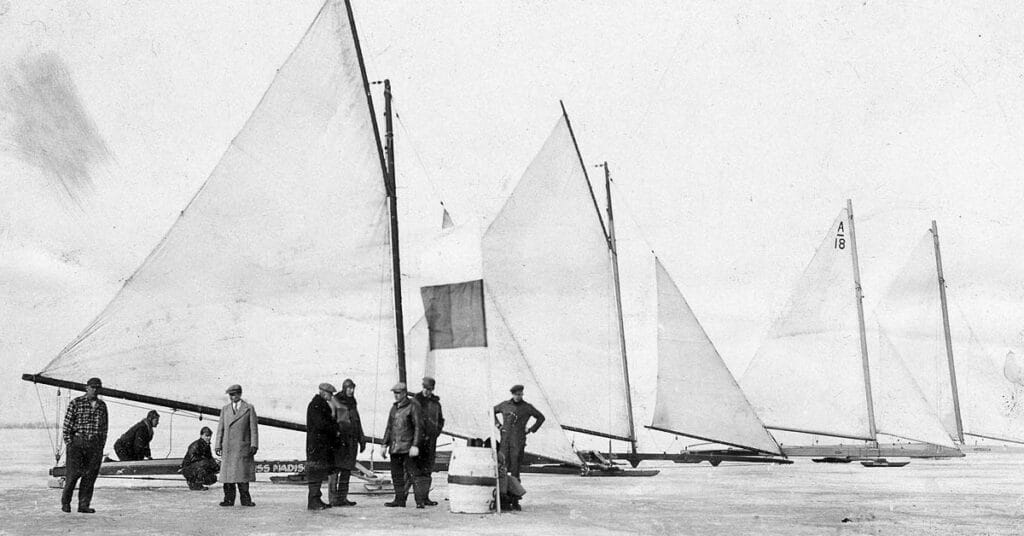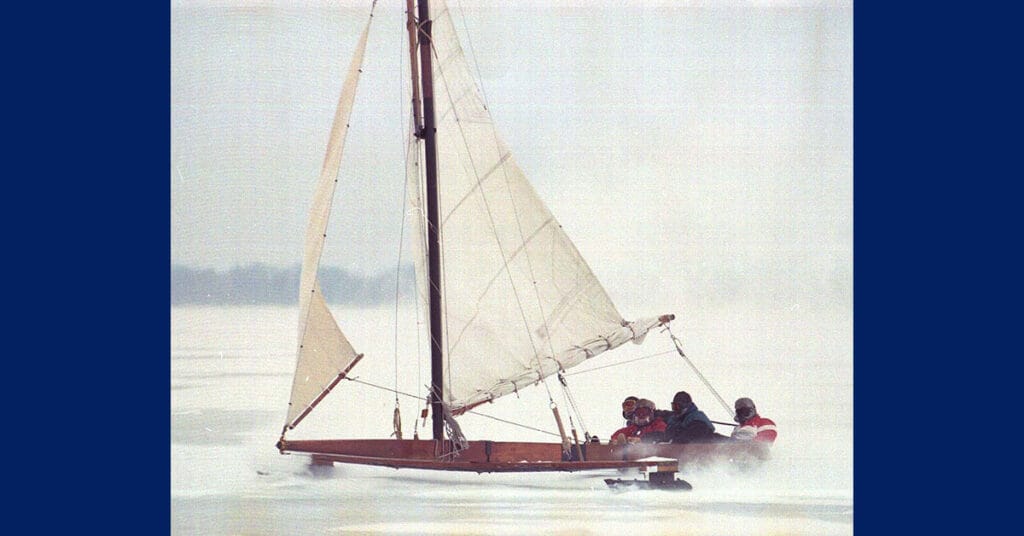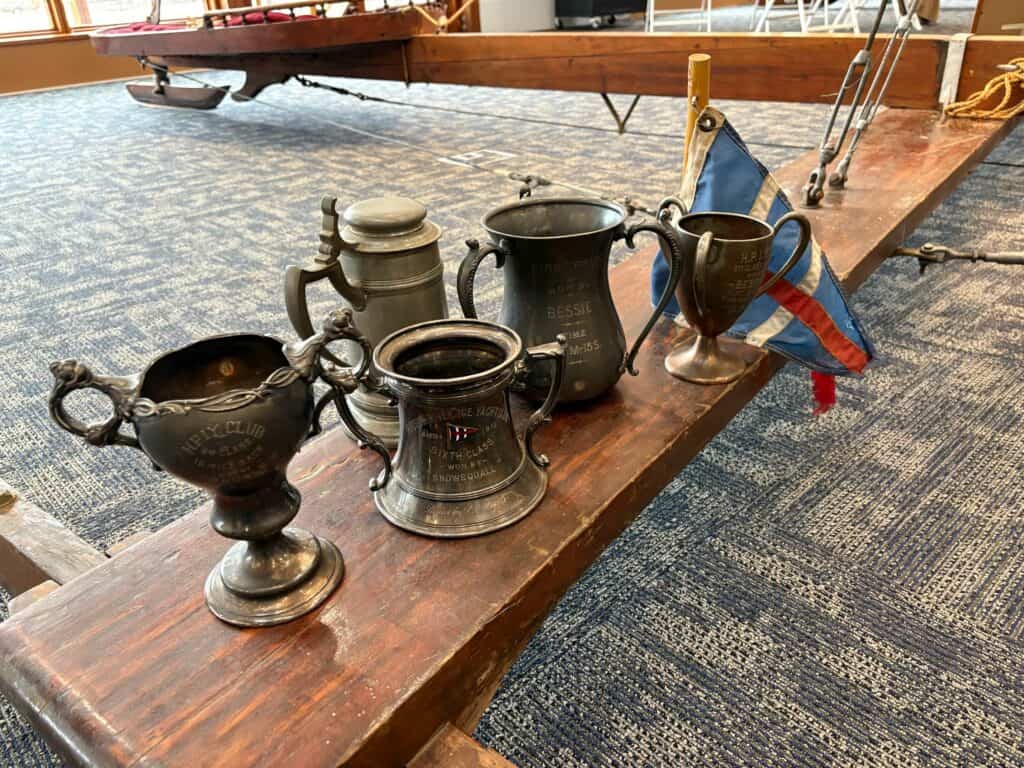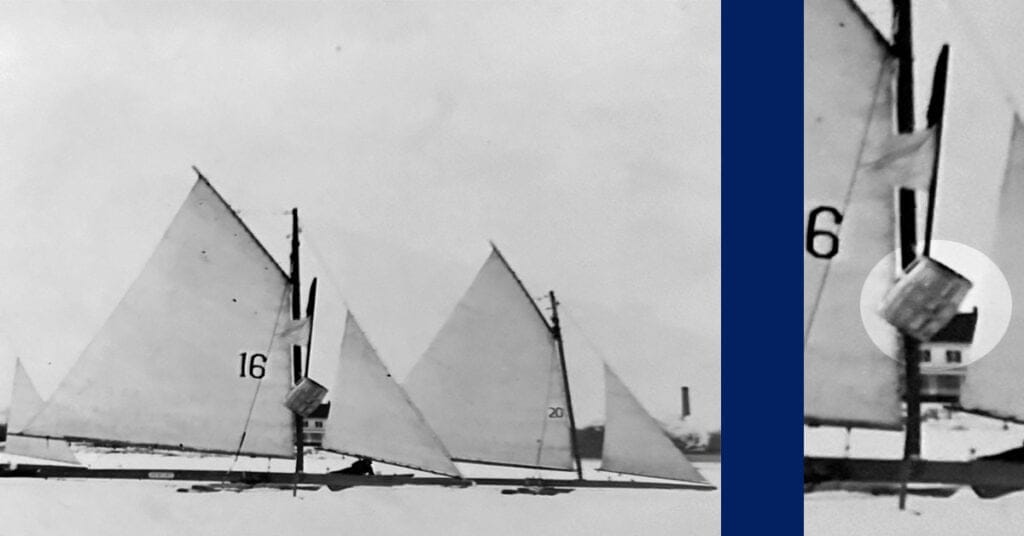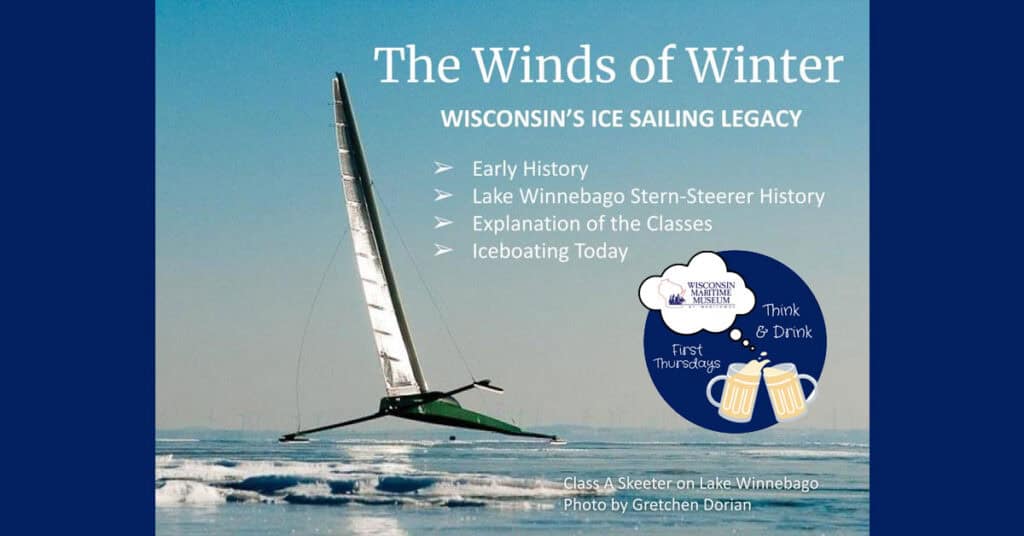by Deb Whitehorse | Jan 20, 2025 | 2024-2025, Home Page, WSSA

Photo: Oshkosh Museum
The Oshkosh Public Museum recently shared a photo on its Facebook page that immediately caught the attention of Lake Winnebago stern-steerer sailor Andy Gratton. He quickly identified the boats:
“The closest boat is the MISS MADISON from Madison and still exists at the Iceboating Foundation in Madison with two other historic boats. I am fairly certain the second boat is the PRINCESS II, also from Madison, owed by Emil Fauerbach. The furthest boat is the FLYING DUTCHEMEN, originally owned by the Van Dyke brothers of Milwaukee. John Buckstaff acquired the boat at some time and frequently raced it. That boat is currently on the ice in front of the Fond du Lac Yacht Club. owned by Dave Lallier and Dave Whealon.”
Through further digging, ice sailing history expert Henry Bossett tracked down a newspaper article that aligns with the era and context of the photo. It’s likely from the 1930 Hearst Trophy Regatta on Lake Winnebago. In this event, Buckstaff and his crew, sailing FLYING DUTCHMEN , defended and won the trophy in light air conditions. MISS MADISON appears largely unchanged and has now joined the collection of historic iceboats at the Iceboat Foundation. As for PRINCESS II, the mystery of her fate remains unsolved.
It’s amazing how these historical pieces resurface and connect in unexpected ways.
Further reading:
MISS MADISON ARCHIVES
PRINCESS II ARCHIVES
FLYING DUTCHMEN ARCHIVES
HEARST CUP ARCHIVES

Like this:
Like Loading...
by Deb Whitehorse | Jan 16, 2025 | 2024-2025, Home Page, WSSA

A great story about a rescued stern-steerer, via Chris Wolford:
I want to thank you and the contributors to the Hudson River Ice Yacht Club for publishing the recent articles on old ice yachts. It is fascinating to read about the races held as far back as 1898 and learn about the men who built these majestic ice yachts. Although there was ice yacht racing in Erie, PA, around that time, there were only a handful of boats, and they are long gone. Ice conditions like you have in Wisconsin are uncommon on Presque Isle Bay, so sailors here get frustrated, mostly because of the amount of snow we get, and the old boats end up in barn rafters and garages. But not all of them.
In the spring of 1986, while rummaging around the basement of the Erie Yacht Club (EYC), in a dark and musty corner, I noticed a couple of long planks leaning against the wall. I was curious, so I took a look and found that it was an old ice yacht. On the backbone was a plaque that read SNIPE, built for Annie Scott Strong in 1900. The car was badly damaged from years of neglect, and the backbone had a bit of rot. I couldn’t just leave it there, so I found the owner and convinced him to sell it to me. I bought it for the outstanding storage charge of $60.
Two iceboating buddies and I spent Monday nights for a year bringing her back to life. We sanded off red paint and found green and, finally, the beautiful wood grain. The runner plank, a little over 6″ thick, still had bark on it. Wrapped in an old sail, the spars and standing rigging were stuffed into the rafters. They were in decent condition, and we were surprised to find a dozen hand-forged brass blocks. We spent about $2000 rebuilding her and replacing the sails. The following winter, we proudly put SNIPE on the ice and renamed her BLACK ICE. We sailed her for 35 years on Presque Isle Bay and made great memories for many people young and old.
In 2018, we were frustrated that we either had no ice or our seasons were so short that it was hardly worth getting her on the ice. And now, in our mid-60s, BLACK ICE started getting heavier. We decided to find a better home for her than the EYC basement, so we approached the Erie Maritime Museum to see if they were interested. The curator was thrilled, and we submitted paperwork to the Commonwealth of PA Museum Commission for approval.
While we waited, we did some research and learned that the yacht was built in the Hudson River Valley and brought here by rail in 1900. She was a birthday present for Annie Scott Strong from her husband, Charles. He was a prosperous businessman, an iron & coal magnate, and a railroad president. Annie’s father was also a railroad tycoon, the Mayor of Erie in 1866, and later served as a U.S. Congressman. We have no idea how long Annie sailed SNIPE, but we believe the boat sat outside for some years in the 1930s and then had several owners before us.
The Museum Commission unanimously approved accepting our gift. On April 26, 2023, BLACK ICE was displayed at the museum at a reception attended by 60 people. Many pictures and a rolling video are included in the display. It’s hard to say how long she will be on display, but we are told that the plan is at least 5 years because of its popularity. When eventually stored, BLACK ICE will be in good company amongst the spars of the tall ship U.S.S. Brig NIAGRA.
Like this:
Like Loading...
by Deb Whitehorse | Jan 10, 2025 | 2024-2025, Home Page, WSSA

Racing trophies that are still cherished by iceboat builder Samuel Rogers’ family. Photo from White Wings & Black Ice
Here is the latest Hudson River Ice Yacht Club newsletter for those who enjoy following the stories of the original historic stern steerers that sailed the Hudson River many years ago. One highlight from the newsletter is a report about the recent exhibit at the FDR Museum and Library in Hyde Park, which showcased the legacy of an iceboat builder and racer, Samuel R. Rogers.
If you’d like to learn more about Samuel R. Rogers and the history of Hudson River ice yachts, visit Brian Reid’s incredible website White Wings and Black Ice. Check out the full Hudson River Ice Yacht Club newsletter or more stories and updates.
Like this:
Like Loading...
by Deb Whitehorse | Dec 29, 2024 | 2024-2025, Home Page, WSSA

Here’s a fascinating vintage photo shared from Mike Peter’s collection, which will be part of our presentation at the Wisconsin Maritime Museum on January 2. This early 20th-century image captures stern steerers racing on Lake Winnebago and shows a very different approach to racecourse marks.
In the photo, you’ll notice the mark (aka buoy) in use—a tall wooden pole mounted on a platform, with a flag waving from the top and a wooden barrel suspended below. This setup starkly contrasts the lightweight, triangular fluorescent fabric marks we use today. It’s hard not to imagine the chaos (and potential splinters!) if one of those massive stern steerers collided with such a substantial obstacle.
This photo likely predates the introduction of bow-steering boats, offering a window into a bygone era of ice sailing. It’s a reminder of how much the sport has evolved.
We’ve had several requests for the special Skeeter Vodka cocktail recipe featured at our event with the Wisconsin Maritime Museum. I’m working on getting that recipe so everyone can mix up their Skeeter cocktail and join us from home via Zoom. Stay tuned—I’ll share it soon so you can toast along with us!
Like this:
Like Loading...
by Deb Whitehorse | Dec 28, 2024 | 2024-2025, Home Page

Does it get any more Wisconsin than this? Ice sailing, maritime history, a Green Bay Packers connection, and a cocktail named in honor of the Skeeter class?
Mike Peters and I will be presenting a program for their Think & Drink series on ice sailing at the Wisconsin Maritime Museum on Thursday, January 2nd at 6:30 pm. I’ll be joining via Zoom, and Mike will be there in person at the museum to share the history of ice sailing in Wisconsin.
The event is free and will be available both in-person and virtually. The featured drink of the night will be a Skeeter, a vodka cocktail named after the fastest iceboat in the world. Doors and the bar open at 6:00 pm, and the program begins at 6:30 pm.
This presentation is part of the Ice Boating: A Wisconsin Tradition exhibit at the Wisconsin Maritime Museum, which is on display from December 2024 through September 2025. The exhibit traces the history of ice boating in Wisconsin, spanning over 100 years, and showcases the evolution of iceboats and the culture surrounding the sport.
To join virtually, please register here: Event Registration Link.
This program is made possible in part by a grant from the Green Bay Packers Foundation. For more info, check out the museum’s website.
Hope to see you there, whether in person or online!
WHAT TO KNOW
Date & Time: Thursday, January 2nd, 6:30 pm (doors and bar open at 6:00 pm)
Location: Wisconsin Maritime Museum, 75 Maritime Dr., Manitowoc, WI
Cost: Free (both in-person and virtual)
Virtual Access: Register here to attend via Zoom: Event Registration Link
UPDATE: The Wisconsin Maritime Museum has unveiled a signature drink for their Think and Drink presentation—a twist on the classic Sidecar, featuring vodka and blue curaçao.
The Skeeter
2 oz vodka
1 oz blue curaçao
1 oz fresh lemon juice
1/2 oz simple syrup (optional, for a hint of sweetness)
Lemon twist or orange slice for garnish
Instructions:
Fill a cocktail shaker with ice.
Add vodka, blue curaçao, lemon juice, and simple syrup (if desired).
Shake well until chilled.
Strain into a chilled coupe glass.
Garnish with a lemon twist or orange slice.
Like this:
Like Loading...
